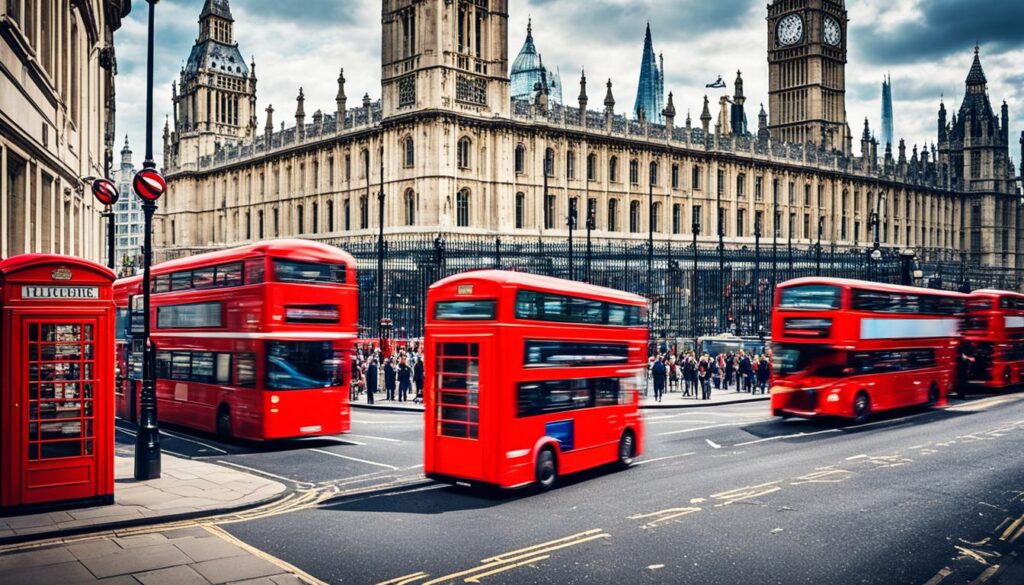Discover the Best Time to Visit Europe – Insider Tips!
Are you planning a trip to Europe but unsure about the best time to go? Should you brave the summer crowds for warm weather or opt for a quieter shoulder season? It’s time to uncover the secret to planning the ultimate European vacation!
Key Takeaways:
- Mid-April to mid-June and September are the ideal seasons to travel to Europe.
- Shoulder seasons offer pleasant weather, lower prices, and fewer tourists.
- Summer months are the peak tourist season in Europe, with crowded attractions and higher prices.
- Consider the specific destination in Europe as weather and tourist crowds can vary.
- Winter can offer lower prices but colder weather and shorter daylight hours.
When is the Best Time to Go to Europe?
Planning a trip to Europe? Timing is crucial in ensuring a memorable and enjoyable vacation. The ideal season to travel Europe, known as the shoulder season, offers a perfect balance of pleasant weather, lower prices, and fewer tourist crowds. Make the most out of your European adventure by traveling during the optimal periods.
The peak tourist season in Europe occurs during the summer months when the weather is hot, and popular attractions are bustling with visitors. While this time may be appealing, it comes with its drawbacks, such as higher prices and longer queues. However, if you prefer warmer temperatures and vibrant city vibes, the summer may still be the ultimate European vacation timing for you.
On the other hand, traveling to Europe during the winter can be a more budget-friendly option. With colder weather and shorter daylight hours, some attractions may have limited operating hours. If you don’t mind bundling up and exploring streets blanketed in snow, you can take advantage of lower prices and a unique winter ambiance.
However, for a truly exceptional experience, consider planning your European escapade during the shoulder seasons. Mid-April to mid-June and September offer favorable weather conditions, fewer tourists, and opportunities to enjoy popular destinations without the overwhelming crowds. Plus, you may even find discounted rates on accommodations and flights, making it an ideal season to travel Europe.
The following table summarizes the key factors to consider when deciding the best time to go to Europe:
| Factors to Consider | Peak Tourist Season | Shoulder Season | Winter Season |
|---|---|---|---|
| Weather | Hot and sunny | Pleasant | Cold |
| Tourist Crowds | High | Fewer | Varies |
| Prices | Higher | Potentially lower | Lower |
| Operating Hours | Extended hours | Regular hours | Varies |
Factors to Consider When Deciding When to Go to Europe

When planning your trip to Europe, it’s essential to take into account several factors that will help determine the best time to visit. Consider the following:
- Specific Destination: Different parts of Europe have varying climates and weather patterns. Some regions may experience milder winters, while others have hot summers. Research the climate and weather conditions of your desired destination to ensure a pleasant and enjoyable trip.
- Weather Preferences: Think about your personal preferences when it comes to weather. Do you enjoy warmer temperatures or prefer cooler climates? Consider the type of activities you want to do during your trip and choose a season that aligns with your preferences.
- Tolerance for Crowds: Keep in mind that summer is the peak tourist season in Europe. If you prefer to avoid heavy crowds and long queues at popular attractions, consider visiting during the shoulder seasons when tourist numbers are lower.
- Budget: Travel expenses can vary depending on the time of the year. During peak tourist seasons, prices for accommodations, flights, and attractions tend to be higher. If you’re on a tight budget, consider traveling during the off-peak seasons when prices are more affordable.
- Events and Festivals: Check if there are any specific festivals or events happening during your desired travel dates. Attending unique cultural celebrations or major events can add an extra layer of excitement to your trip.
Now let’s take a closer look at the different seasons and the optimal periods to visit Europe:
Shoulder Seasons: A Balance of Good Weather and Lower Prices
The shoulder seasons, which typically run from mid-April to mid-June and September to mid-October, offer a balance of good weather and lower prices. These periods are less crowded compared to the peak summer season, allowing you to enjoy popular attractions without dealing with overwhelming crowds.
Traveling during the shoulder seasons can provide you with a more authentic and relaxed experience as you explore Europe’s iconic landmarks and attractions.
You can expect milder temperatures during the day and cooler evenings, making it ideal for outdoor activities like sightseeing, hiking, and exploring historic sites. Additionally, you may find better deals on accommodations and flights during these periods, making it a budget-friendly choice for many travelers.
Summer: The Prime Time for Europe Travel
If warm weather, longer daylight hours, and vibrant city life are what you’re seeking, then summer is the prime time to visit Europe. The summer months, especially July and August, attract a high volume of tourists, particularly in popular cities like Paris, Rome, and Barcelona.
Visiting Europe during the summer allows you to experience the lively ambiance, enjoy outdoor dining, and witness various cultural events and festivals.
Be prepared for higher accommodation prices and longer queues at popular attractions. Make sure to plan ahead, book your accommodations, and purchase tickets to attractions in advance to avoid any disappointments.
Winter: Cheaper Travel Options, But Colder Weather
If you’re on a tight budget and don’t mind colder temperatures, winter can be an excellent time to visit Europe. Traveling during the winter months, typically from November to February, offers the advantage of lower prices for accommodations and flights.
However, it’s important to note that some attractions may have reduced opening hours or even be closed during this time. Additionally, winter weather in certain regions can be quite harsh, with snowfall and shorter daylight hours. Plan your activities accordingly and be prepared for colder temperatures by packing appropriate clothing and accessories.
Best Time to Go to London

London, the vibrant capital of England, offers a blend of history, culture, and modern attractions all year round. However, there are certain times that stand out as the best for a visit. The ideal season to travel to London and make the most of your European vacation is during the shoulder seasons of April and May, or September and October.
During these months, London enjoys milder weather, with average temperatures ranging from 9 to 15°C (48 to 59°F). It’s the perfect time to explore the city’s iconic landmarks, such as the Tower of London, Buckingham Palace, and the British Museum, without the excessive crowds of the summer months.
Navigating the bustling streets of London becomes easier during these shoulder seasons, and you can also expect potentially lower prices for accommodations and attractions. This makes it a prime time to visit for budget-conscious travelers.
Summer, from June to August, is the peak tourist season in London. The city is buzzing with activity, but you’ll also encounter larger crowds and longer queues at popular attractions. Prices tend to be higher during this time, so if you prefer a quieter experience, it’s best to avoid the summer months.
Winter, from December to February, can be cold and rainy in London. While the city is adorned with festive lights and decorations, it’s important to wrap up warm and be prepared for the occasional downpour. However, if you don’t mind the chilly weather, winter can offer its own charm and potentially lower prices for accommodations.
In summary, the best time to go to London is during the shoulder seasons of April and May, or September and October. These months provide milder weather, fewer crowds, and potentially lower prices, ensuring an enjoyable and cost-effective trip.
Best Time to Go Interrailing

Interrailing across Europe is a dream adventure for many travelers. The freedom of exploring multiple countries with a single train pass makes it an ideal way to experience the diverse cultures and breathtaking landscapes of the continent. But when is the best time to embark on this unforgettable journey?
The prime time for interrailing in Europe is during the autumn months of September and October. During this season, the weather is still pleasant, with mild temperatures and fewer chances of rain. It’s the perfect time to wander through historic cities, hike in picturesque mountains, and soak up the beauty of Europe at a leisurely pace.
One of the main advantages of traveling in September and October is the thinner tourist crowds. Unlike the peak summer season, when popular destinations are packed with visitors, you can have a more authentic and intimate experience during the autumn months. You’ll have more space to explore famous landmarks, enjoy local cuisine, and interact with the locals.
Additionally, traveling during the autumn can also offer more affordable prices. Prices for accommodation, attractions, and transportation tend to be lower compared to the peak summer season. This allows you to make the most of your budget and potentially extend your interrail adventure to more destinations.
While summer is the peak season for interrailing, it comes with its own set of challenges. The popular routes and trains can be crowded, and prices for accommodations may be higher. If you prefer a quieter and more budget-friendly experience, the autumn months are an excellent alternative.
It’s worth noting that winter, particularly November and December, may not be the best time for interrailing due to the colder weather and the possibility of some attractions being closed. However, if you don’t mind the chilly temperatures and are interested in experiencing the festive atmosphere of European Christmas markets, December can still be a magical time to embark on your interrail journey.
So, if you’re planning to go interrailing in Europe, make sure to consider September and October as the prime time for your adventure. Experience the beauty of Europe without the summer crowds, enjoy pleasant weather, and take advantage of potentially lower prices. It’s the perfect opportunity to create incredible memories as you explore the diverse wonders of the continent.
Interrailing in September and October – A Snapshot:
| Advantages | Considerations |
|---|---|
|
|
Embark on your interrail adventure during the best time to go interrailing. September and October offer the perfect blend of favorable weather, fewer crowds, and potential cost savings. Get ready to explore the enchanting wonders of Europe and create lifelong memories as you journey through this breathtaking continent.
Best Time to Go to Paris

When planning your trip to Paris, it’s important to consider the best time to go to ensure an enjoyable experience. The ideal season to travel to Europe’s iconic capital is during the shoulder seasons of April and May, or September and October. During these months, Paris offers pleasant weather, fewer crowds, and potentially lower prices.
Visiting Paris in the spring allows you to witness the city in bloom, with vibrant flowers adorning gardens and tree-lined boulevards. The weather is mild and perfect for exploring popular attractions such as the Eiffel Tower, Louvre Museum, and Notre-Dame Cathedral.
In the fall, Paris is equally enchanting with its autumn foliage. The city exudes a cozy ambiance as temperatures cool down. You can enjoy leisurely walks along the Seine River, indulge in delicious French cuisine at charming outdoor cafes, and immerse yourself in the vibrant arts and culture scene.
However, it’s important to note that summer is the peak tourist season in Paris. The city sees an influx of visitors from around the world, resulting in larger crowds and higher accommodation prices. It’s advisable to book hotels and attractions in advance if you plan to visit during this time.
“Paris is always a good idea.” – Audrey Hepburn
During winter, Paris can be cold and rainy. However, if you don’t mind bundling up and braving the occasional drizzle, you can take advantage of lower prices and shorter lines at popular tourist spots. The city is adorned with festive decorations, and you can experience the magic of Paris during the holiday season.
Summary:
To make the most of your visit to Paris, the best time to go is during the shoulder seasons of April and May, or September and October. These months offer pleasant weather, fewer crowds, and potentially lower prices. While summer attracts more tourists, winter can be cold and rainy but offers the advantage of lower prices. Whether you choose to explore the City of Lights during spring, summer, fall, or winter, the enchanting ambiance and iconic landmarks of Paris will undoubtedly leave a lasting impression.
Best Time for Sightseeing in Europe

Sightseeing in Europe is a dream for many travelers, and choosing the right time to visit can make a significant difference in your experience. While Europe is a year-round destination, there are certain seasons that offer the best conditions for sightseeing. The ideal time to explore the iconic landmarks, stunning architecture, and vibrant cities of Europe is during the spring months of April and May, or the autumn months of September and October.
During the spring and autumn seasons, Europe experiences milder weather, which allows for comfortable outdoor exploration. The temperatures are pleasant, usually ranging from 55°F to 70°F (13°C to 21°C), creating a perfect atmosphere for walking tours, visiting museums, and enjoying the beautiful outdoor cafes. These seasons also offer fewer crowds compared to the peak summer months, allowing you to fully immerse yourself in the local culture and enjoy popular attractions without long queues or overcrowding.
However, it’s important to note that summer, especially during July and August, is considered the peak tourist season in Europe. While the weather is generally warm and sunny, popular tourist destinations can become crowded, and attractions may have longer wait times. If you prefer sightseeing under these conditions, be prepared for larger crowds and consider booking tickets and accommodations in advance.
On the other hand, winters in Europe, especially in the northern regions, can be cold and some attractions may have limited operating hours. However, this can be an excellent time to explore European cities adorned with festive decorations during the holiday season, such as the famous Christmas markets in Germany and Austria.
Ultimately, the best time for sightseeing in Europe depends on your preferences and the specific destinations you plan to visit. Consider the weather, crowd levels, and any festivals or events that may be of interest to you. Researching and planning ahead will help you make the most out of your European sightseeing adventure.
Cheapest Time to Visit Europe

If you’re looking for budget-friendly options for your European adventure, January is typically the cheapest time to visit Europe. This off-peak season offers lower prices and thinner crowds compared to the peak summer months. However, it’s important to keep in mind that the weather can be cold, especially in northern Europe.
Alternatively, consider visiting during the shoulder seasons of April and May, or September and October. These months may also offer lower prices compared to the peak summer months, while still providing pleasant weather and a chance to explore Europe without the heavy tourist crowds.
Keep in mind that the specific destination within Europe can also impact pricing. Major cities such as London or Paris may have different price patterns compared to smaller towns or countryside destinations.
| Month | Cheapest Time to Visit Europe |
|---|---|
| January | Off-peak season with lower prices |
| April and May | Shoulder season with lower prices and pleasant weather |
| September and October | Shoulder season with lower prices and mild temperatures |
“Traveling during the off-peak season or shoulder seasons is a great way to save money and avoid crowds. Prices are generally more affordable, and you’ll have a chance to experience Europe with a more relaxed atmosphere.”
Whether you choose to visit during the cheapest time in January or prefer the shoulder seasons, planning ahead and doing some research can help you find the optimal time for your European adventure while staying within your budget.
Conclusion
In conclusion, determining the best time to visit Europe is a matter of personal preference, taking into account factors such as climate, crowd tolerance, and budget. The shoulder seasons of mid-April to mid-June and September offer a favorable balance of pleasant weather, fewer tourists, and potentially lower prices. However, if you enjoy a vibrant atmosphere and don’t mind bigger crowds, summer is the peak tourist season in Europe.
On the other hand, if budget is a priority and you don’t mind colder temperatures, winter can be a more affordable time to plan your European vacation. It’s important to consider your destination within Europe, as the weather and tourist crowds can vary significantly across different regions.
To ensure you make the most of your European vacation, research and planning ahead is essential. Take into account any specific festivals or events you want to attend, and consider the optimal timing for visiting your desired attractions. By doing so, you can find the ultimate timing that aligns with your preferences and ensures an unforgettable experience exploring the beautiful continent of Europe.







